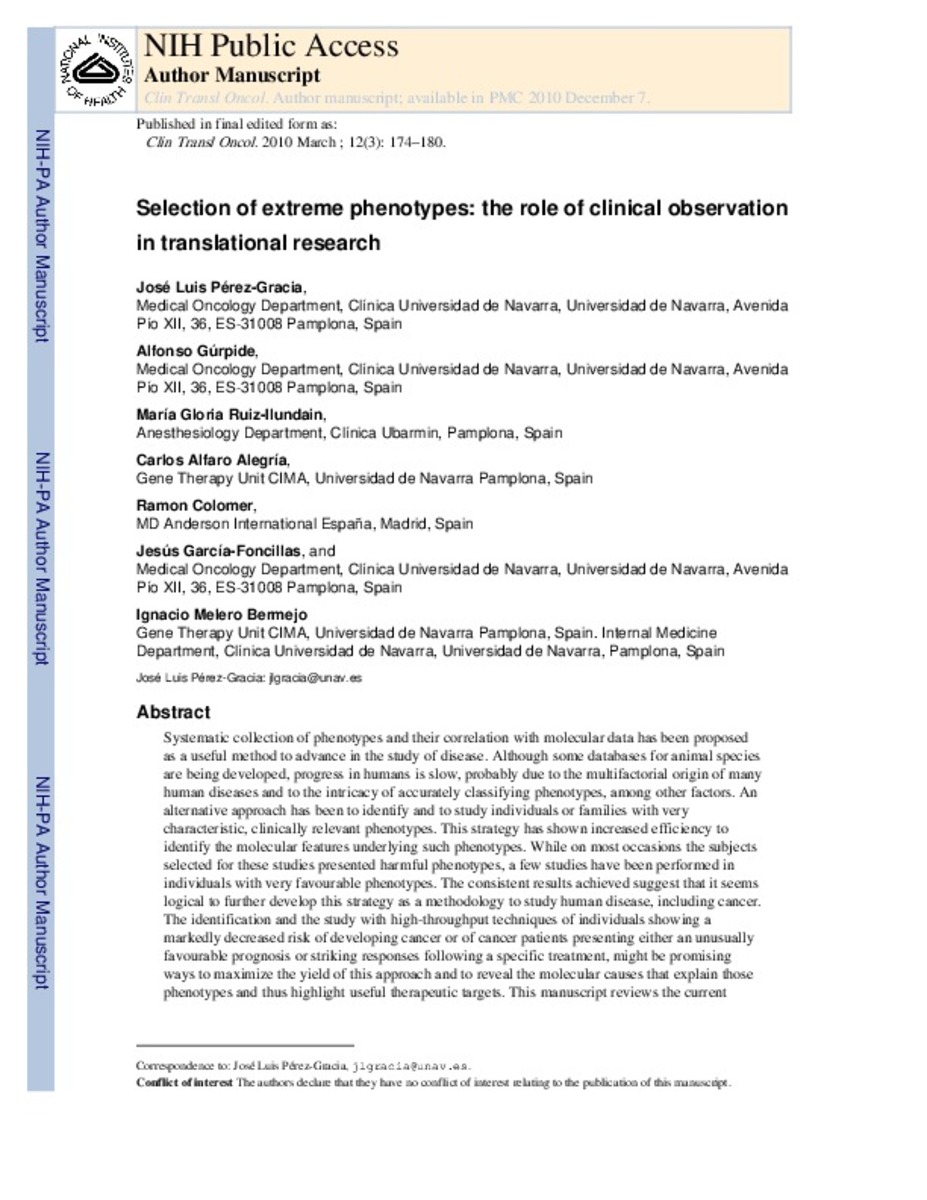Full metadata record
| DC Field | Value | Language |
|---|---|---|
| dc.creator | Perez-Gracia, J.L. (Jose Luis) | - |
| dc.creator | Gurpide, A. (Alfonso) | - |
| dc.creator | Ruiz-Ilundain, M.G. (María Gloria) | - |
| dc.creator | Alfaro, C. (Carlos) | - |
| dc.creator | Colomer, R. (Ramón) | - |
| dc.creator | Garcia-Foncillas, J. (Jesús) | - |
| dc.creator | Melero, I. (Ignacio) | - |
| dc.date.accessioned | 2012-06-08T17:54:13Z | - |
| dc.date.available | 2012-06-08T17:54:13Z | - |
| dc.date.issued | 2010 | - |
| dc.identifier.citation | Perez-Gracia JL, Gurpide A, Ruiz-Ilundain MG, Alfaro Alegria C, Colomer R, Garcia-Foncillas J, et al. Selection of extreme phenotypes: the role of clinical observation in translational research. Clin Transl Oncol 2010 Mar;12(3):174-180. | es_ES |
| dc.identifier.issn | 1699-048X | - |
| dc.identifier.uri | https://hdl.handle.net/10171/22512 | - |
| dc.description.abstract | Systematic collection of phenotypes and their correlation with molecular data has been proposed as a useful method to advance in the study of disease. Although some databases for animal species are being developed, progress in humans is slow, probably due to the multifactorial origin of many human diseases and to the intricacy of accurately classifying phenotypes, among other factors. An alternative approach has been to identify and to study individuals or families with very characteristic, clinically relevant phenotypes. This strategy has shown increased efficiency to identify the molecular features underlying such phenotypes. While on most occasions the subjects selected for these studies presented harmful phenotypes, a few studies have been performed in individuals with very favourable phenotypes. The consistent results achieved suggest that it seems logical to further develop this strategy as a methodology to study human disease, including cancer. The identification and the study with high-throughput techniques of individuals showing a markedly decreased risk of developing cancer or of cancer patients presenting either an unusually favourable prognosis or striking responses following a specific treatment, might be promising ways to maximize the yield of this approach and to reveal the molecular causes that explain those phenotypes and thus highlight useful therapeutic targets. This manuscript reviews the current status of selection of extreme phenotypes in cancer research and provides directions for future development of this methodology. | es_ES |
| dc.language.iso | eng | es_ES |
| dc.publisher | Springer Verlag | es_ES |
| dc.rights | info:eu-repo/semantics/openAccess | es_ES |
| dc.subject | Cancer genetics | es_ES |
| dc.subject | Protective genetic alterations | es_ES |
| dc.subject | Single-nucleotide polymorphisms | es_ES |
| dc.title | Selection of extreme phenotypes: the role of clinical observation in translational research | es_ES |
| dc.type | info:eu-repo/semantics/article | es_ES |
| dc.relation.publisherversion | http://www.ncbi.nlm.nih.gov/pmc/articles/PMC2997959/?tool=pubmed | es_ES |
| dc.type.driver | info:eu-repo/semantics/article | es_ES |
Files in This Item:
Statistics and impact
Items in Dadun are protected by copyright, with all rights reserved, unless otherwise indicated.






